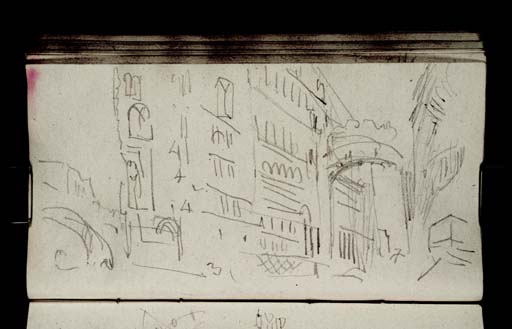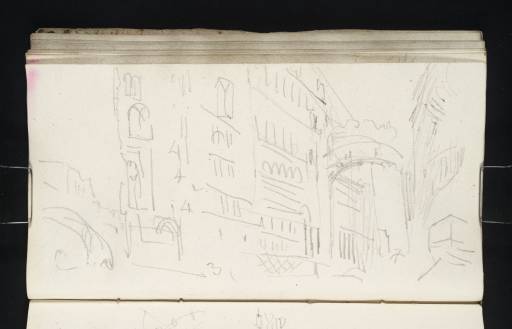Joseph Mallord William Turner The Palazzo Ducale (Doge's Palace), Venice, from the Ponte della Paglia to the Bridge of Sighs and Beyond, along the Rio del Palazzo opposite the New Prisons 1833
Image 1 of 2
-
 Joseph Mallord William Turner, The Palazzo Ducale (Doge's Palace), Venice, from the Ponte della Paglia to the Bridge of Sighs and Beyond, along the Rio del Palazzo opposite the New Prisons 1833
Joseph Mallord William Turner, The Palazzo Ducale (Doge's Palace), Venice, from the Ponte della Paglia to the Bridge of Sighs and Beyond, along the Rio del Palazzo opposite the New Prisons 1833 -
 Joseph Mallord William Turner, The Palazzo Ducale (Doge's Palace), Venice, from the Ponte della Paglia to the Bridge of Sighs and Beyond, along the Rio del Palazzo opposite the New Prisons 1833 (Enhanced image)Enhanced image
Joseph Mallord William Turner, The Palazzo Ducale (Doge's Palace), Venice, from the Ponte della Paglia to the Bridge of Sighs and Beyond, along the Rio del Palazzo opposite the New Prisons 1833 (Enhanced image)Enhanced image
Joseph Mallord William Turner,
The Palazzo Ducale (Doge's Palace), Venice, from the Ponte della Paglia to the Bridge of Sighs and Beyond, along the Rio del Palazzo opposite the New Prisons
1833
Joseph Mallord William Turner 1775–1851
Folio 62 Verso:
The Palazzo Ducale (Doge’s Palace), Venice, from the Ponte della Paglia to the Bridge of Sighs and Beyond, along the Rio del Palazzo opposite the New Prisons 1833
D32048
Turner Bequest CCCXIV 62a
Turner Bequest CCCXIV 62a
Pencil on white laid paper, 109 x 203 mm
Inscribed by Turner ‘4 | 4 | 4’ left of centre, and ‘3’ bottom centre on façade
Inscribed by Turner ‘4 | 4 | 4’ left of centre, and ‘3’ bottom centre on façade
Accepted by the nation as part of the Turner Bequest 1856
References
1909
A.J. Finberg, A Complete Inventory of the Drawings of the Turner Bequest, London 1909, vol.II, p.1015, CCCXIV 62a, as ‘Do.’ [i.e. ditto: Bridge of Sighs and] Ducal Palace’.
1984
Hardy George, ‘Turner in Europe in 1833’, Turner Studies, vol.4, no.1, Summer 1984, p.14.
The Turner scholar C.F. Bell annotated Finberg’s 1909 Inventory entry (‘Bridge of Sighs and Ducal Palace’): ‘from the Rio di Palazzo’.1 The drawing was made with the page turned horizontally. This is one of a short sequence of pages with views in the vicinity of the elevated Bridge of Sighs, on the Rio del Palazzo between the Palazzo Ducale (Doge’s Palace) and New Prisons; see under folio 61 verso (D32046) for details and further discussion. For this sketchbook’s general sequence, including Hardy George’s broad overview,2 see its Introduction.
Here, the perspective and habitual lateral compression are particularly extreme, with the north side of the Ponte della Paglia shown on the left, the east side of the palace receding sharply northwards to the right, and the west front of the prisons on the right, advancing southwards back along the narrow canal to the bridge, with the Bridge of Sighs as it were holding the space together.
The section of the palace’s heavily articulated façade to the right of centre is entirely in stone, with a sense of its long rows of arched and rectangular windows, and emphatic rustication above the waterline. The arch beside the bridge on the left is at the south-west corner, with the storeys above largely of brick with stone dressings. It is unclear what the nearby ‘3’ denotes, as there are four small windows at that level. Likewise, the repeated ‘4’s above hardly do justice to subtle variations in the fenestration. The arch was blocked up at that time, but now gives access to the open arcade along the whole Molo front.
At the corner, there is no sign of the high-relief stone sculptures flanking the head of the arch, while above there is a loose indication of the Archangel Raphael figure on its pillar (at the end of the loggia overlooking the Bacino). This feature is over-emphasised and too wide, while the Gothic windows above are too near the corner, where a cursory wavy line hints at the delicate barley-sugar spiral form of the stonework. The same corner is rendered with more care in the view from the south on folio 5 recto (D31936); compare the detailed treatment of this part in Richard Parkes Bonington’s large oil painting Venice: Ducal Palace with a Religious Procession, exhibited in 1828 (Tate N05789).
Matthew Imms
May 2019
How to cite
Matthew Imms, ‘The Palazzo Ducale (Doge’s Palace), Venice, from the Ponte della Paglia to the Bridge of Sighs and Beyond, along the Rio del Palazzo opposite the New Prisons 1833 by Joseph Mallord William Turner’, catalogue entry, May 2019, in David Blayney Brown (ed.), J.M.W. Turner: Sketchbooks, Drawings and Watercolours, Tate Research Publication, March 2023, https://www

